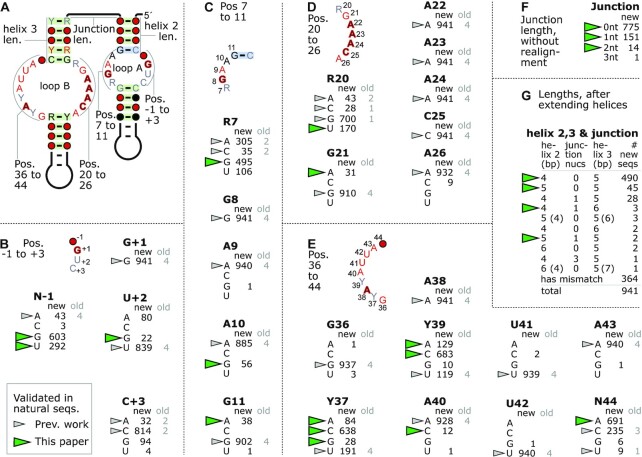Figure 2.
Detailed conservation analysis of 941 hairpin ribozymes. (A) The indicated seven regions of particular structural importance in the hairpin ribozyme are analyzed in parts B-G. Base pairs in non-Watson–Crick interactions are analyzed in Supplementary Figure S8. (B) The number of each of the four nucleotides observed in each indicated position is given. For perfectly conserved positions (e.g. G+1), only the relevant nucleotide is shown. Nucleotide positions are named after the conserved nucleotide in part A (‘N’ = no specific nucleotide was conserved) and the standard hairpin ribozyme position number. For example, the previous name U39 is now Y39 in this figure. ‘new’: numbers of sequences out of the 941 novel hairpin ribozymes. ‘old’: numbers based on the previously established four hairpin ribozymes. Nucleotides that were present in experimentally validated natural sequences prior to the current paper are indicated by gray triangles. Nucleotides present in any of the 941 sequences that we confirmed as functional are indicated by green triangles (details in Supplementary Table S3). These definitions and the boxed legend also applies to parts C–G. (C) Conservation of positions 7–11. (D) Conservation of positions 20–26. (E) Conservation of positions 36–44. (F) Lengths of the junction between helices 2 and 3. These calculations ignored the possibility of non-canonical pairs or indels in the computationally predicted helices, and the possibility that junction nucleotides could extend a helix. Old sequences are not analyzed because the junction is specific to our proposed permutation. (G) Analysis of helices 2 and 3 with the junction. Here, 364 sequences with a mismatch or indel in predicted helix 2 or 3 pairs were not analyzed. We added junction nucleotides to helix 2 or 3 if they would form Watson–Crick or G–U pairs. In rare cases, it was possible to add a given nucleotide to either helix 2 or helix 3, and the alternate possibilities are given in parentheses. Note: non-Watson–Crick base pair interactions are not depicted or analyzed in Figure 2, but are in Supplementary Figure S8 (see also Supplementary Table S4).

